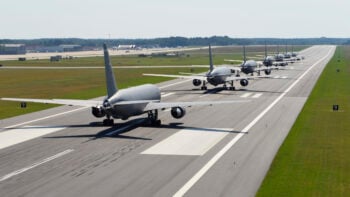
A KC-46 tanker refuels a C-17 transport in mid-air.
WASHINGTON: You’d think Boeing and the Air Force would have learned from Lockheed Martin’s experience with the F-35 and concurrency, which Vice Adm. James Venlet identified six years ago in our pages as a fundamental “miscalculation” in the Joint Strike Fighter program.
The issue came to light Friday during a conversation about the KC-46 tanker with the Program Executive Officer and the KC-46 program manager, Col. John Newberry. I asked why what we’ve always been told was a low-risk program had suffered the delays, cost overruns, and technical problems it has.
“I think one of the risks we probably underestimated collectively was concurrency ,” conceded Newberry, referring to the building of production model aircraft while still finishing ground and flight testing. In the case of the tanker, Boeing was modifying a new version of the 767 it needed to get a Federal Aviation Authority airworthiness certificate. “I think Boeing is now paying for those underestimates,”the colonel added.
Newberry pushed back against my questioning of the program’s status as low-risk, given the cost and schedule overruns. “Overall, this program was low -risk,” he said, noting that six planes are flying after six years and taxpayers haven’t had to pay a dime more. “There’s a lot of good news.”
Boeing made its bid with the reasonable expectation that it would more than recoup any funds lost during the initial stages of the procurement as it later sold and serviced more tankers. The taxpayer is getting a plane on a fixed price basis, so Boeing has had to absorb the billions in cost overruns. We still have to see if and how they are punished monetarily. Delivery of the first six tankers are expected by the Air Force at the end of spring 2018. Boeing has said that it can get there by December.
Army inching towards late FY25 Chinook Block II full-rate production contract
Boeing recently announced the Block II helo’s first maiden flight and plans to deliver the first production aircraft to the service in the coming weeks.


























